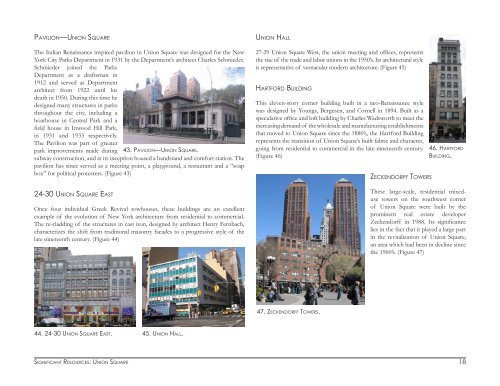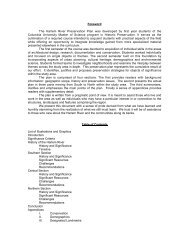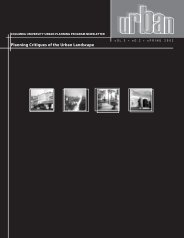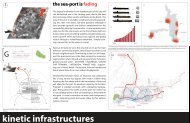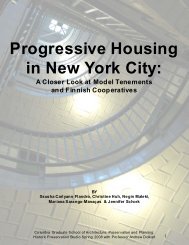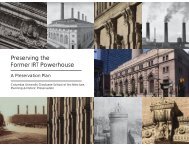14th street and union square preservation plan - Columbia ...
14th street and union square preservation plan - Columbia ...
14th street and union square preservation plan - Columbia ...
Create successful ePaper yourself
Turn your PDF publications into a flip-book with our unique Google optimized e-Paper software.
PAVILION—UNION SQUARE<br />
UNION HALL<br />
The Italian Renaissance inspired pavilion in Union Square was designed for the New<br />
York City Parks Department in 1931 by the Department’s architect Charles Schmieder.<br />
Schmieder joined the Parks<br />
Department as a draftsman in<br />
1912 <strong>and</strong> served as Department<br />
architect from 1922 until his<br />
death in 1950. During this time he<br />
designed many structures in parks<br />
throughout the city, including a<br />
boathouse in Central Park <strong>and</strong> a<br />
field house in Inwood Hill Park,<br />
in 1931 <strong>and</strong> 1933 respectively.<br />
The Pavilion was part of greater<br />
park improvements made during<br />
subway construction, <strong>and</strong> at its inception housed a b<strong>and</strong>st<strong>and</strong> <strong>and</strong> comfort station. The<br />
pavilion has since served as a meeting point, a playground, a restaurant <strong>and</strong> a “soap<br />
box” for political protesters. (Figure 43)<br />
27-29 Union Square West, the <strong>union</strong> meeting <strong>and</strong> offices, represents<br />
the rise of the trade <strong>and</strong> labor <strong>union</strong>s in the 1950’s. Its architectural style<br />
is representative of vernacular modern architecture. (Figure 45)<br />
HARTFORD BUILDING<br />
This eleven-story corner building built in a neo-Renaissance style<br />
was designed by Youngs, Bergesen, <strong>and</strong> Cornell in 1894. Built as a<br />
speculative office <strong>and</strong> loft building by Charles Wadsworth to meet the<br />
increasing dem<strong>and</strong> of the wholesale <strong>and</strong> manufacturing establishments<br />
that moved to Union Square since the 1880’s, the Hartford Building<br />
represents the transition of Union Square’s built fabric <strong>and</strong> character,<br />
going from residential to commercial in the late nineteenth century.<br />
(Figure 46)<br />
43. PAVILION—UNION SQUARE.<br />
46. HARTFORD<br />
ZECKENDORFF TOWERS<br />
BUILDING.<br />
24-30 UNION SQUARE EAST<br />
Once four individual Greek Revival rowhouses, these buildings are an excellent<br />
example of the evolution of New York architecture from residential to commercial.<br />
The re-cladding of the structures in cast iron, designed by architect Henry Fernbach,<br />
characterizes the shift from traditional masonry facades to a progressive style of the<br />
late nineteenth century. (Figure 44)<br />
These large-scale, residential mixeduse<br />
towers on the southwest corner<br />
of Union Square were built by the<br />
prominent real estate developer<br />
Zeckendorff in 1988. Its significance<br />
lies in the fact that it played a large part<br />
in the revitalization of Union Square,<br />
an area which had been in decline since<br />
the 1960’s. (Figure 47)<br />
47. ZECKENDORFF TOWERS.<br />
44. 24-30 UNION SQUARE EAST. 45. UNION HALL.<br />
SIGNIFICANT RESOURCES: UNION SQUARE<br />
18


